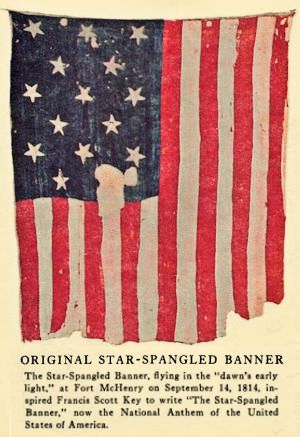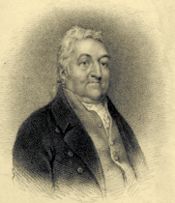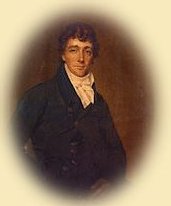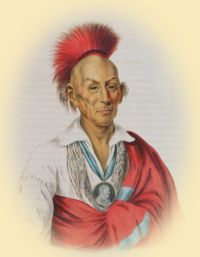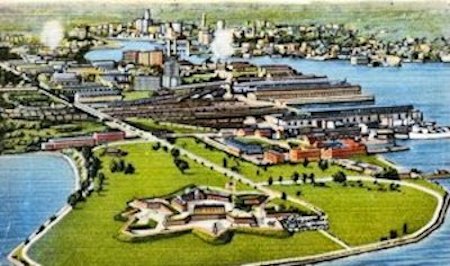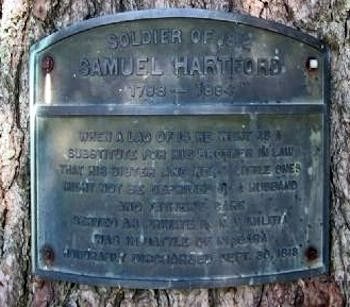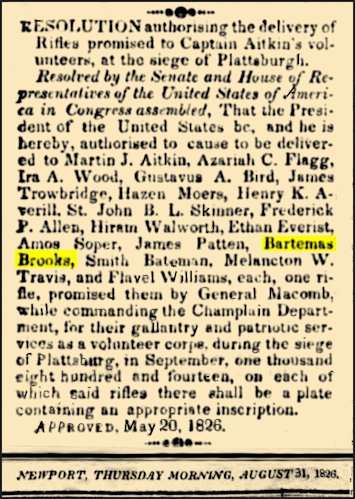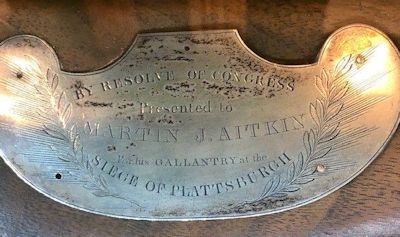|
|
Clark County, Wisconsin 1812 Veterans The Star-Spangled Banner, formerly known as "the Great Garrison Flag", was flown over Fort McHenry in Baltimore Harbor (shown below) during the naval portion of the Battle of Baltimore during the War of 1812. It is on exhibit at the National Museum of American History, Smithsonian Institution. Seeing the flag flying over Fort McHenry on the morning of September 14, 1814, after the battle ended, Francis Scott Key was inspired to write the poem "Defence of Fort McHenry". These words were written by Key and set to the tune of "To Anacreon in Heaven" by John Stafford Smith, a popular song at the time. In 1931 the song became the national anthem of the United States. More broadly, a garrison flag is a U.S. Army term for an extra-large national flag that is flown on Sundays, holidays, and special occasions. The U.S. Navy term is "holiday colors". With fifteen stripes, the Star-Spangled Banner remains the only official American flag to bear more than thirteen stripes.
|
|
1820 Portrait of John S. Smith
Francis Scott Key abt. 1825 |
Anacreontic Lyrics
************** Francis Scott Key (August 1, 1779 – January 11, 1843)[3] was an American lawyer, author, and amateur poet from Frederick, Maryland, who wrote the lyrics for the American national anthem "The Star-Spangled Banner".[4] Key observed the British bombardment of Fort McHenry in 1814 during the War of 1812. He was inspired upon seeing the American flag still flying over the fort at dawn and wrote the poem "Defence of Fort McHenry"; it was published within a week with the suggested tune of the popular song "To Anacreon in Heaven". The song with Key's lyrics became known as "The Star-Spangled Banner" and slowly gained in popularity as an unofficial anthem, finally achieving official status more than a century later under President Herbert Hoover as the national anthem. |
|
||||
|
Francis Scott Key observing the flag the morning after the battle. by Edward Percy Moran, 1913
Black Hawk |
||||||
|
"The Battle of Wisconsin Heights: Black Hawk's account"
I was mounted on a fine horse, and was pleased to see my warriors so brave. I addressed them in a loud voice, telling them to stand their ground, and never yield it to the enemy. At this time I was on the rise of a hill, where I wished to form my warriors, that we might have some advantage over the whites. But the enemy succeeded in gaining this point, which compelled us to fall back into a deep ravine, from which we continued firing at them and they at us, until it began to grow dark.
My horse having been wounded twice during this engagement, and fearing from his loss of blood, that he would soon give out--and finding that the enemy would not come near enough to receive our fire, in the dusk of the evening--and knowing that our women and children had had sufficient time to reach the island in the Ouisconsin, I ordered my warriors to return, in different routes, and meet me at the Ouisconsin--and were astonished to find that the enemy were not disposed to pursue us. In this skirmish, with fifty braves, I defended and accomplished my passage over the Ouisconsin, with a loss of only six men; though opposed by a host of mounted militia. I would not have fought there, but to gain time for my women and children to cross to an island. A warrior will duly appreciate the embarrassments I labored under--and whatever may be the sentiments of the white people, in relation to this battle, my nation, though fallen, will award to me the reputation of a great brave in conducting it. The loss of the enemy could not be ascertained by our party; but I am of opinion, that it was much greater, in proportion, than mine. We returned to the Ouisconsin, and crossed over to our people.
Myself and band having no means to descend the Ouisconsin, I started, over a rugged country, to go to the Mississippi, intending to cross it, and return to my nation. Many of our people were compelled to go on foot, for want of horses, which, in consequence of their having had nothing to eat for a long time, caused our march to be very slow. At length we arrived at the Mississippi, having lost some of our old men and little children, who perished on the way with hunger. Wisconsin State Historical Society |
||||||
|
Fort McHenry, Baltimore, MD
|
||||||
|
The War of 1812 pitted the young
United States in a war against Great Britain, from whom
the American colonies had won their independence in 1783.
The conflict was a byproduct of the broader conflict between
Great Britain and France over who would dominate Europe
and the wider world.
[The Battle of Lake Champlain, 11 September 1814]
|
||||||
Master Veteran's Burial Index for the War of 1812
|
NAME |
CEMETERY |
TOWN |
NOTES |
|---|---|---|---|
|
Brooks, Bartemas |
LYNN |
LYNN |
NY Pvt in Capt Aiken's Co. NY b 20 Nov 1786 d 2 July 1875; Obit / Bio |
|
French, John |
NEILLSVILLE |
PINE VALLEY |
|
|
Hartford, Samuel |
PINE GROVE |
LOYAL |
1798-1884; Bio, Cemetery History |
|
Johnson, Andrew |
NORWEGIAN |
MAYVILLE |
31 Dec 1792 - 13 Feb 1871; Bio; |
|
Kimball, Hannibal |
NEILLSVILLE |
PINE VALLEY |
|
|
Palmer, Johnathan |
BUTLER |
Capt. Martin Aiken led boy soldiers against British
By Lohr McKinstry, Press-Republican Sep 14, 2014 Updated Sep
24, 2014
WILLSBORO — Martin James Aiken united a group of young boys
during the War of 1812 to defend a bridge crucial to the
Battle of Plattsburgh. They were forever after known as
Aiken’s Volunteers. In 1814, Aiken knew the War of 1812 was
not going well for the United States, and he was ready to do
what he could. He realized Gen. Alexander Macomb had too few
men to hold off 10,000 British troops amassed at the
Canadian border. Macomb needed help as the Village of
Plattsburgh prepared for a British invasion.
BOYS NEEDED SPONSOR
The boys of the Plattsburgh Academy wanted to help the
general, but they were too young to enlist, said author Joy
Demarse of Peru, and that’s where Martin Aiken came
in.Demarse wrote “Nine Days a Soldier,” a historical novel
about Aiken’s Volunteers, which follows Hiram Walworth, a
14-year-old student who was a member of the group. “General
Macomb would not have allowed them to enlist,” she said in
an interview with the Press-Republican. “Someone basically
said, ‘If you can find yourselves a sponsor, you can
volunteer.’ Then the sponsor’s name would go down into the
registration. That’s how Aiken became the captain.“That way
General Macomb did not have to say they were under 18.”
GOOD SCOUTS
Aiken, a farmer who was only 21 years old himself, stepped
forward and formed Aiken’s Volunteer Rifle Company with 20
young men from the academy, plus himself and Lt. Azariah
Flagg.“The boys were ages 14 to 17,” Demarse said. “They
were able to scout very well. Macomb needed every shot he
could get. They were quite the good company.”It was
September 1814, and the British were marching south toward
Plattsburgh — but under the surveillance of Aiken’s
Volunteers.“They knew the land well and could scout,”
Demarse said. “They developed very accurate pictures of
where the British were and what they were doing.”
ONLY ONE BOY LOST
On Sept. 6, 1814, Aiken and his company fought in the
morning alongside an overwhelmed local militia and were
beaten back by the British on Beekmantown Road. In the
afternoon, Aiken told his men to fall back to Plattsburgh
and take up sniper positions in a mill on the east side of
the Saranac River, defending a bridge the British wanted to
cross. “It was a small company, but they were very effective
and efficient,” Demarse said.
Aiken was a good commander. He had the planks taken up from
the bridge to keep the British troops from crossing it, and
when they tried to ford the river, Aiken and the boys picked
them off. Only one of Aiken’s force was killed, a
14-year-old boy named Peters, whose first name is unknown,
Demarse said.
AWARDED RIFLES
On Sept. 11, 1814, the British left in disorder after losing
the Battle of Plattsburgh, heading back to Canada. Aiken’s
Volunteers were disbanded the next day. But their service
was not forgotten. Aiken and his company were praised by
Macomb for their gallantry, and the general promised that
each of them should receive a rifle. On May 20, 1826,
Congress rewarded the youths for their bravery by issuing
each of them “one rifle, promised them by General Macomb,
while commanding the Champlain Department, for their
gallantry and patriotic services as a volunteer corps during
the siege of Plattsburg. On each of which said rifles there
shall be a plate containing an appropriate inscription.” The
rifles went to Aiken and Flagg and former academy students
Ira Wood, Gustavus Bird, James Trowbridge, Hazen Mooers,
Henry K. Averill, St. John B. L. Skinner, Frederick Allen,
Hiram Walworth, Ethan Everist, Amos Soper, James Patten,
Bartemus Brooks, Melancthon Travis, Smith Bateman and Flavel
Williams, along with other lads whose names are unknown. The
rifles were a Hall’s breech-loader, with an inscription on
the breech: “Be resolved of Congress presented to (name of
volunteer) for his gallantry at the siege of Plattsburg.”
“It’s the only time in our history that civilians were
awarded a rifle by Congress,” Demarse said. “They advocated
for these young boys to receive a rifle in honor of their
service.
|
© Every submission is protected by the Digital Millennium Copyright Act of 1998.
Show your appreciation of this freely provided information by not copying it to any other site without our permission.
Become a Clark County History Buff
|
|
A site created and
maintained by the Clark County History Buffs
Webmasters: Leon Konieczny, Tanya Paschke, Janet & Stan Schwarze, James W. Sternitzky,
|
